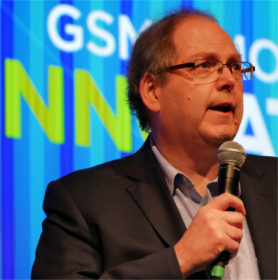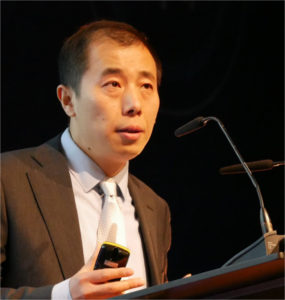Mobile IoT – The Road Ahead

By Abraham Joseph -
26 February 2019 – This year, the GSMA kicked off Mobile World Congress (MWC) with the 6th Mobile IoT Summit, an event that proved especially popular with a broad range of stakeholders.
The event was sponsored by Huawei, Sequans, T-Mobile and Nokia, the former two of which delivered keynotes.
The summit was opened and closed by Graham Trickey, Head of IoT at GSMA (above). In his opening comments he provided an update on progress of mobile or cellular IoT, i.e. solutions using licensed spectrum. He indicated that three were 41 commercical launches plus 50 pilots worldwide by February 2018 supported by an ecosystem that includes 80 leading vendors and over 800 innovator companies.
 In his keynote, Cheng Zhu, Head of Cellular IoT Products at Huawei (left) highlighted the progress his company has been making in global trials and deployments, highlighting particular success in many verticals in China.
In his keynote, Cheng Zhu, Head of Cellular IoT Products at Huawei (left) highlighted the progress his company has been making in global trials and deployments, highlighting particular success in many verticals in China.
Huawei focuses its IoT efforts in three areas: smart city, smart industry and smart life. He believes that there will be 100 commercial networks offering mobile services by the end of 2018.
He presented a series of case studies including smart meters and connected bicycles and indicated that he and his team have been working on commercial aspects that will help operators develop business cases. He believes that mobile IoT offers great opportunities for operators but that ecosystem partnership will be key in scaling deployments. He indicated that Huawei had over 3,000 partners in its ecosystem.
 In his keynote, Dr Georges Karan, CEO, Sequans (right) discussed the progress his company has been making on providing chipsets for the mobile IoT ecosystem. Although their initial focus was on LTE-M they have since released additional versions of their Monarch design optimised for a range of applications including wearables.
In his keynote, Dr Georges Karan, CEO, Sequans (right) discussed the progress his company has been making on providing chipsets for the mobile IoT ecosystem. Although their initial focus was on LTE-M they have since released additional versions of their Monarch design optimised for a range of applications including wearables.
So, which variant of mobile IoT will win in the medium term? Will it be LTE-M or NB-IoT? There was surprising agreement among participants, including the operator panel that followed the keynotes, that both will survive. Furthermore, for an operator contemplating deployment, the choice ought to be driven by the operator's existing network deployment and the specific applications that will be the operator's primary focus.






